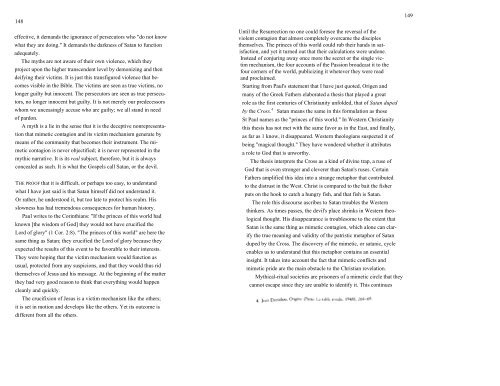I See Satan Fall Like Lightning
I See Satan Fall Like Lightning
I See Satan Fall Like Lightning
Create successful ePaper yourself
Turn your PDF publications into a flip-book with our unique Google optimized e-Paper software.
148<br />
effective, it demands the ignorance of persecutors who "do not know<br />
what they are doing." It demands the darkness of <strong>Satan</strong> to function<br />
adequately.<br />
The myths are not aware of their own violence, which they<br />
project upon the higher transcendent level by demonizing and then<br />
deifying their victims. It is just this transfigured violence that be-<br />
comes visible in the Bible. The victims are seen as true victims, no<br />
longer guilty but innocent. The persecutors are seen as true persecu-<br />
tors, no longer innocent but guilty. It is not merely our predecessors<br />
whom we unceasingly accuse who are guilty; we all stand in need<br />
of pardon.<br />
A myth is a lie in the sense that it is the deceptive nonrepresenta-<br />
tion that mimetic contagion and its victim mechanism generate by<br />
means of the community that becomes their instrument. The mi-<br />
metic contagion is never objectified; it is never represented in the<br />
mythic narrative. It is its real subject, therefore, but it is always<br />
concealed as such. It is what the Gospels call <strong>Satan</strong>, or the devil.<br />
THE PROOF that it is difficult, or perhaps too easy, to understand<br />
what I have just said is that <strong>Satan</strong> himself did not understand it.<br />
Or rather, he understood it, but too late to protect his realm. His<br />
slowness has had tremendous consequences for human history.<br />
Paul writes to the Corinthians: "If the princes of this world had<br />
known [the wisdom of God] they would not have crucified the<br />
Lord of glory" (1 Cor. 2:8). "The princes of this world" are here the<br />
same thing as <strong>Satan</strong>; they crucified the Lord of glory because they<br />
expected the results of this event to be favorable to their interests.<br />
They were hoping that the victim mechanism would function as<br />
usual, protected from any suspicions, and that they would thus rid<br />
themselves of Jesus and his message. At the beginning of the matter<br />
they had very good reason to think that everything would happen<br />
cleanly and quickly.<br />
The crucifixion of Jesus is a victim mechanism like the others;<br />
it is set in motion and develops like the others. Yet its outcome is<br />
different from all the others.<br />
Until the Resurrection no one could foresee the reversal of the<br />
violent contagion that almost completely overcame the disciples<br />
themselves. The princes of this world could rub their hands in sat-<br />
isfaction, and yet it turned out that their calculations were undone.<br />
Instead of conjuring away once more the secret or the single vic-<br />
tim mechanism, the four accounts of the Passion broadcast it to the<br />
four corners of the world, publicizing it whetever they were read<br />
and proclaimed.<br />
Starting from Paul's statement that I have just quoted, Origen and<br />
many of the Greek Fathers elaborated a thesis that played a great<br />
role as the first centuries of Christianity unfolded, that of <strong>Satan</strong> duped<br />
by the Cross. 4 <strong>Satan</strong> means the same in this formulation as those<br />
St Paul names as the "princes of this world." In Western Christianity<br />
this thesis has not met with the same favor as in the East, and finally,<br />
as far as 1 know, it disappeared. Western theologians suspected it of<br />
being "magical thought." They have wondered whether it attributes<br />
a role to God that is unworthy.<br />
The thesis interprets the Cross as a kind of divine trap, a ruse of<br />
God that is even stronger and cleverer than <strong>Satan</strong>'s ruses. Certain<br />
Fathers amplified this idea into a strange metaphor that contributed<br />
to the distrust in the West. Christ is compared to the bait the fisher<br />
puts on the hook to catch a hungry fish, and that fish is <strong>Satan</strong>.<br />
The role this discourse ascribes to <strong>Satan</strong> troubles the Western<br />
thinkers. As times passes, the devil's place shrinks in Western theo-<br />
logical thought. His disappearance is troublesome to the extent that<br />
<strong>Satan</strong> is the same thing as mimetic contagion, which alone can clar-<br />
ify the true meaning and validity of the patristic metaphor of <strong>Satan</strong><br />
duped by the Cross. The discovery of the mimetic, or satanic, cycle<br />
enables us to understand that this metaphor contains an essential<br />
insight. It takes into account the fact that mimetic conflicts and<br />
mimetic pride are the main obstacle to the Christian revelation.<br />
Mythical-ritual societies are prisoners of a mimetic circle that they<br />
cannot escape since they are unable to identify it. This continues<br />
149
















